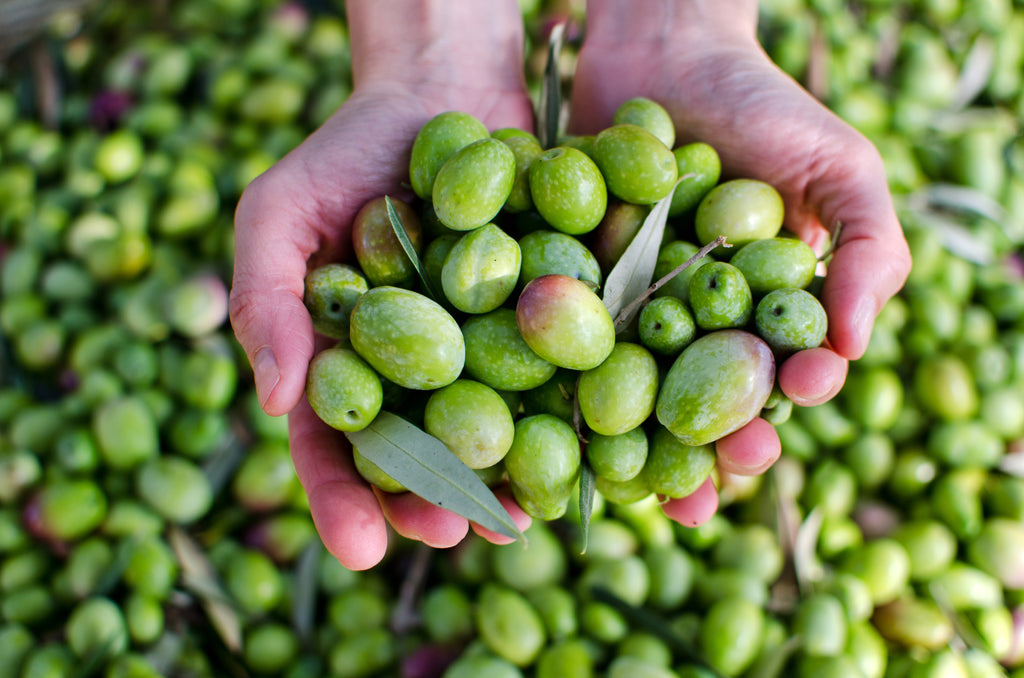A History of Olive Oil Part 1

My great grandmother was nine years old when she immigrated from Sicily on one of the last boats through Ellis Island. When I think back to my old grandmother, my fondest memories are all related to food and cooking. I remember sauce made from fresh tomatoes that seemed to cook all day, heaps of garlic, and those bready anise Easter cookies braided around hard boiled eggs. I remember my first mostly permitted taste of red wine with dinner, and of course olive oil. Olive oil was something that I just took for granted as a kid, it was always there. It was everywhere, actually; on the holiday dinner table, the kitchen table, in the cabinet and on the counter. Even my mother, raised by a German father, has used olive oil as long as I can remember. Naturally I had just assumed that it was a staple in everyone's kitchen.
Several years ago, I had the opportunity to visit France and spent a few nights on a small private olive grove in the south. It was so beautiful, and being there brought back fond memories of my nona. I remember wishing that I could call her to tell her all about it, even though it would have been unacceptable that I was in France, not Italy or Sicily. I know she would have told me how much better it would have been if I had been in her homeland, but I believe that she would have loved to hear about that experience nonetheless.
Researching the history of olives and olive oil has brought up so many of those same memories. In a way it has helped me feel closer to her, my mother and my father’s familial past. This has been such a fun way for me to retrace a part of my heritage and to learn about this amazing plant.
The first installment of The History of Olive Oil is all about the olive tree itself. It is a journey of its origin, travels and cultivation around the globe and through the ages to the land of my nona and beyond.
The olive tree is more ancient than written language and man has been cultivating it for thousands of years. Those two facts make it extremely difficult to pinpoint the exact lineage of different olive varietals. To compound the difficulties of following a clear genetic line, due to our desire to propagate and cultivate, you can often find the same variety of olive tree in multiple countries called by different names. In the Middle East there is a shrub-like wild variety that is believed to be a descendant of the original wild olive trees. So if the olive tree is native to the region we now know as the Middle East, how did it become such an integral part of Greek and Roman culture and how did it end up here in the States?
This is where our true historical journey begins and where we have to take a look at the maps of the ancient world to make sense of where we are. From all of my research, the first known olive trees date back to the Neolithic era of Asia Minor, specifically ancient Persia and Mesopotamia, as far back as the 8th millennium BC and were harvested by those peoples. From there it is believed that the olive spread to the Mediterranean Basin, specifically modern day Syria and Palestine (Phonetia). There is debate as to when the cultivation of olives actually began. There is a Neolithic excavation site called Kfar Samir where simple olive presses have been found. That would put the cultivation timeline ~5000 BCEon the Carmel Coast of ancient Israel. In the Late Bronze Age Greece started to produce its own olives on Minoan Crete and Cyprus and was the likely source of the wealth of the Minoan Kingdom. Some scholars argue that olive cultivation originated with the Ancient Egyptians since olives have been found in Egyptian tombs from 2,000 BC.
Olive oil not only became a major trading commodity but by this time also had extremely wide cultural significance. It is perhaps most famously known as a branch of peace and as the victor’s crown in the ancient Olympic Games. The success of the industry is attested by records of olive oil exports to Greece and Egypt throughout the 3rd millennium BCE. The Greeks, like the peoples of the Levant, soon produced a surplus of olives and olive oil, and built up a lucrative export industry. Such was the olive’s importance that it was the only permissible export in the celebrated laws created by Solon (c. 640 – c. 560 BCE).
The Phoenicians and Greeks were responsible for the spread of the olive to the Mediterranean shores of North Africa and Iberia from Asia Minor. The Romans began planting on the mainland, had dedicated nursery beds and began grafting domesticated cuttings into wild olive tree trunks. Farmers then planted those trees amongst their fruit trees. Their animals grazed among the groves to combat weeds, which also allowed for multiple sources of income.
As the Romans extended their empire they brought with them not only the olive but their increasing dependency upon it. During the 1st to 3rd centuries CE, despite the need for extensive irrigation, they spread their cultivation to the outreaches of central Tunisia and Western Libya. The demand for olive oil became so great that many farms were established across Syria and Cilicia from the 3rd-5th centuries CE. Dependency was so great that olive oil was collected as part of the taxes and redistributed amongst the populace. Constantinople was one of the largest importers during this period.
After the fall of the Roman Empire, we enter one of my favorite periods, the Middle Ages. This is where the life of the olive tree takes two very different paths. It was also in the Middle Ages that trade routes were created between the olive groves in North Africa and Marseille.
Let us take a brief trip to the less notable (for our purposes) Dark and Middle Ages of Europe. This is where the life of our olive tree seems to become dull. I have not been able to find any proof of the Romans having brought the olive past Italy, south-eastern France and the southern Iberian Peninsula. From what can be found, planting and production of oil were mainly carried out for self-consumption. As can be evidenced from cook books of the time, there was a greatly reduced presence of fat in the medieval diet with the exception of products based on cow's milk, butter or other animal fats. At the end of the Middle Ages there was also a ten year period from 1430-1440 that today would be referred to as a polar vortex. As hearty as the olive tree may be, had any remained in the northern reaches of Europe from the days of Roman rule, the likelihood they would have survived those winters is very slim.
Despite this overall decline in the use of olive for consumption, olive oil was still used for lighting homes, churches, bodily care, and the development of soaps and medicinal potions. In Spain, mention is made of the medicinal uses of olive oil in literature: for example in the medical works of Averroes, who recommended the addition of olive oil in culinary preparations.
Now we return south to the Iberian Peninsula. While still Europe, not all territories were under Christian rule. Most olive groves resided in territories under Muslim rule, which was advantageous for striking agricultural and cultivation treaties. The continued consumption and overall use of olive oil in this portion of Europe is in direct relation to Arab presence as animal fats were forbidden in the Arab religious culture, and olive oil was already a notable commodity. In the kingdom of Al-Andalus, farmers built on the cultivation techniques used by the Romans. Those practices are still used in the region today.
It was in the 15th and 16th centuries that the olive tree was introduced to the Americas. Trees were brought over by Spain and Portugal to their new territories: primarily Mexico, Peru and Argentina. The Franciscans that were sent from Europe to convert the tribes people of the Americas introduced the olive tree to North America. As they established their missions, starting in Southern California, they also planted olive groves. The oldest remaining olive groves in the U.S. are in Northern California, as they have been pushed out by housing and development in the Southern part of the state.
Stay tuned for the next installment, about the “who” and “where” of the production of olive oil, and how we arrived at our current renewal of interest in the “oil of the ages”.
TAGS:
A History of Olive Oil Part 1
My great grandmother was nine years old when she immigrated from Sicily on one of the last boats through Ellis Island. When I think back to my old grandmother, my fondest memories are all related to food and cooking. I remember sauce made from fresh tomatoes that seemed to cook all day, heaps of garlic, and those bready anise Easter cookies braided around hard boiled eggs. I remember my first mostly permitted taste of red wine with dinner, and of course olive oil. Olive oil was something that I just took for granted as a kid, it was always there. It was everywhere, actually; on the holiday dinner table, the kitchen table, in the cabinet and on the counter. Even my mother, raised by a German father, has used olive oil as long as I can remember. Naturally I had just assumed that it was a staple in everyone's kitchen.
Several years ago, I had the opportunity to visit France and spent a few nights on a small private olive grove in the south. It was so beautiful, and being there brought back fond memories of my nona. I remember wishing that I could call her to tell her all about it, even though it would have been unacceptable that I was in France, not Italy or Sicily. I know she would have told me how much better it would have been if I had been in her homeland, but I believe that she would have loved to hear about that experience nonetheless.
Researching the history of olives and olive oil has brought up so many of those same memories. In a way it has helped me feel closer to her, my mother and my father’s familial past. This has been such a fun way for me to retrace a part of my heritage and to learn about this amazing plant.
The first installment of The History of Olive Oil is all about the olive tree itself. It is a journey of its origin, travels and cultivation around the globe and through the ages to the land of my nona and beyond.
The olive tree is more ancient than written language and man has been cultivating it for thousands of years. Those two facts make it extremely difficult to pinpoint the exact lineage of different olive varietals. To compound the difficulties of following a clear genetic line, due to our desire to propagate and cultivate, you can often find the same variety of olive tree in multiple countries called by different names. In the Middle East there is a shrub-like wild variety that is believed to be a descendant of the original wild olive trees. So if the olive tree is native to the region we now know as the Middle East, how did it become such an integral part of Greek and Roman culture and how did it end up here in the States?
This is where our true historical journey begins and where we have to take a look at the maps of the ancient world to make sense of where we are. From all of my research, the first known olive trees date back to the Neolithic era of Asia Minor, specifically ancient Persia and Mesopotamia, as far back as the 8th millennium BC and were harvested by those peoples. From there it is believed that the olive spread to the Mediterranean Basin, specifically modern day Syria and Palestine (Phonetia). There is debate as to when the cultivation of olives actually began. There is a Neolithic excavation site called Kfar Samir where simple olive presses have been found. That would put the cultivation timeline ~5000 BCEon the Carmel Coast of ancient Israel. In the Late Bronze Age Greece started to produce its own olives on Minoan Crete and Cyprus and was the likely source of the wealth of the Minoan Kingdom. Some scholars argue that olive cultivation originated with the Ancient Egyptians since olives have been found in Egyptian tombs from 2,000 BC.
Olive oil not only became a major trading commodity but by this time also had extremely wide cultural significance. It is perhaps most famously known as a branch of peace and as the victor’s crown in the ancient Olympic Games. The success of the industry is attested by records of olive oil exports to Greece and Egypt throughout the 3rd millennium BCE. The Greeks, like the peoples of the Levant, soon produced a surplus of olives and olive oil, and built up a lucrative export industry. Such was the olive’s importance that it was the only permissible export in the celebrated laws created by Solon (c. 640 – c. 560 BCE).
The Phoenicians and Greeks were responsible for the spread of the olive to the Mediterranean shores of North Africa and Iberia from Asia Minor. The Romans began planting on the mainland, had dedicated nursery beds and began grafting domesticated cuttings into wild olive tree trunks. Farmers then planted those trees amongst their fruit trees. Their animals grazed among the groves to combat weeds, which also allowed for multiple sources of income.
As the Romans extended their empire they brought with them not only the olive but their increasing dependency upon it. During the 1st to 3rd centuries CE, despite the need for extensive irrigation, they spread their cultivation to the outreaches of central Tunisia and Western Libya. The demand for olive oil became so great that many farms were established across Syria and Cilicia from the 3rd-5th centuries CE. Dependency was so great that olive oil was collected as part of the taxes and redistributed amongst the populace. Constantinople was one of the largest importers during this period.
After the fall of the Roman Empire, we enter one of my favorite periods, the Middle Ages. This is where the life of the olive tree takes two very different paths. It was also in the Middle Ages that trade routes were created between the olive groves in North Africa and Marseille.
Let us take a brief trip to the less notable (for our purposes) Dark and Middle Ages of Europe. This is where the life of our olive tree seems to become dull. I have not been able to find any proof of the Romans having brought the olive past Italy, south-eastern France and the southern Iberian Peninsula. From what can be found, planting and production of oil were mainly carried out for self-consumption. As can be evidenced from cook books of the time, there was a greatly reduced presence of fat in the medieval diet with the exception of products based on cow's milk, butter or other animal fats. At the end of the Middle Ages there was also a ten year period from 1430-1440 that today would be referred to as a polar vortex. As hearty as the olive tree may be, had any remained in the northern reaches of Europe from the days of Roman rule, the likelihood they would have survived those winters is very slim.
Despite this overall decline in the use of olive for consumption, olive oil was still used for lighting homes, churches, bodily care, and the development of soaps and medicinal potions. In Spain, mention is made of the medicinal uses of olive oil in literature: for example in the medical works of Averroes, who recommended the addition of olive oil in culinary preparations.
Now we return south to the Iberian Peninsula. While still Europe, not all territories were under Christian rule. Most olive groves resided in territories under Muslim rule, which was advantageous for striking agricultural and cultivation treaties. The continued consumption and overall use of olive oil in this portion of Europe is in direct relation to Arab presence as animal fats were forbidden in the Arab religious culture, and olive oil was already a notable commodity. In the kingdom of Al-Andalus, farmers built on the cultivation techniques used by the Romans. Those practices are still used in the region today.
It was in the 15th and 16th centuries that the olive tree was introduced to the Americas. Trees were brought over by Spain and Portugal to their new territories: primarily Mexico, Peru and Argentina. The Franciscans that were sent from Europe to convert the tribes people of the Americas introduced the olive tree to North America. As they established their missions, starting in Southern California, they also planted olive groves. The oldest remaining olive groves in the U.S. are in Northern California, as they have been pushed out by housing and development in the Southern part of the state.
Stay tuned for the next installment, about the “who” and “where” of the production of olive oil, and how we arrived at our current renewal of interest in the “oil of the ages”.

